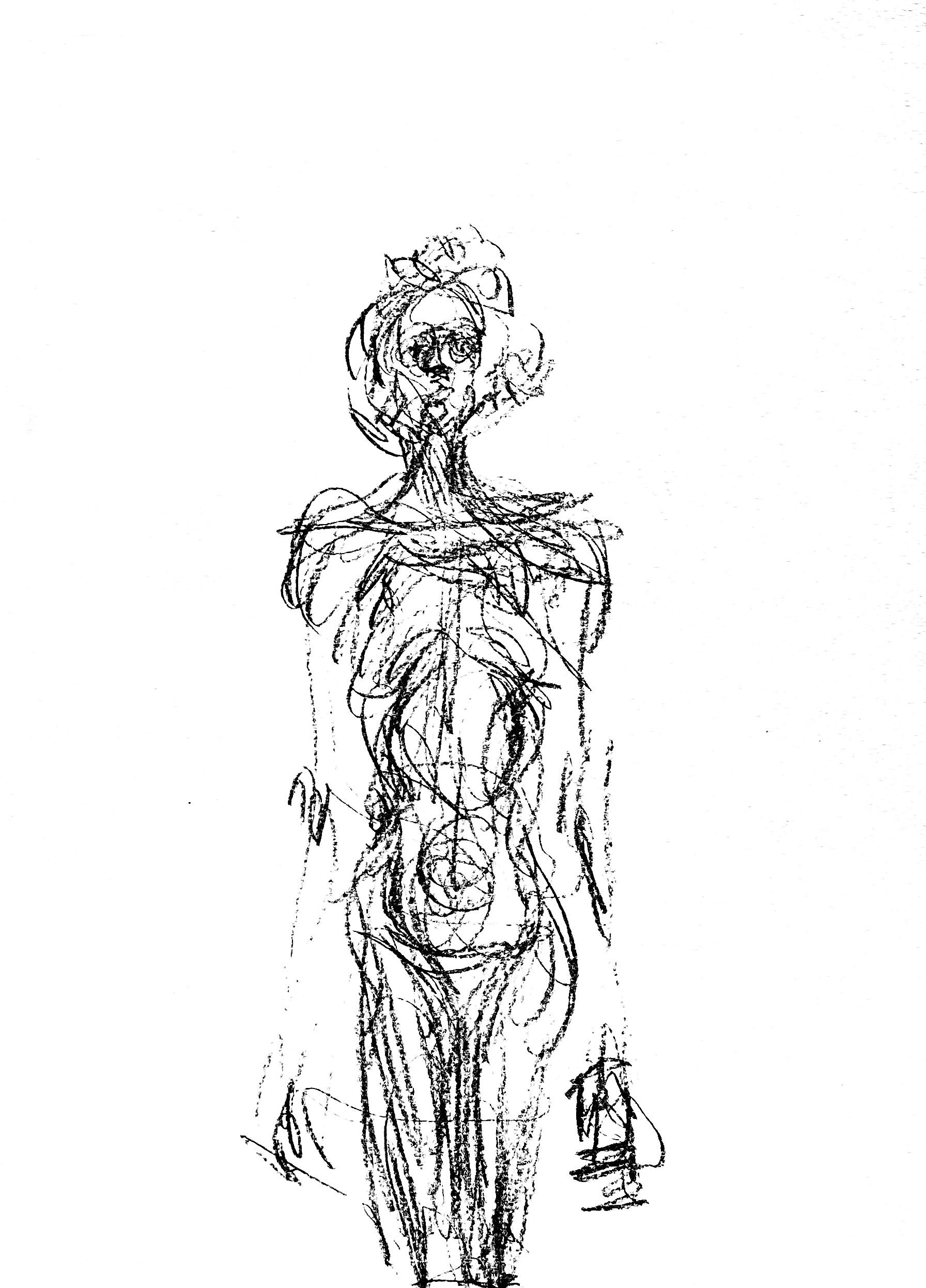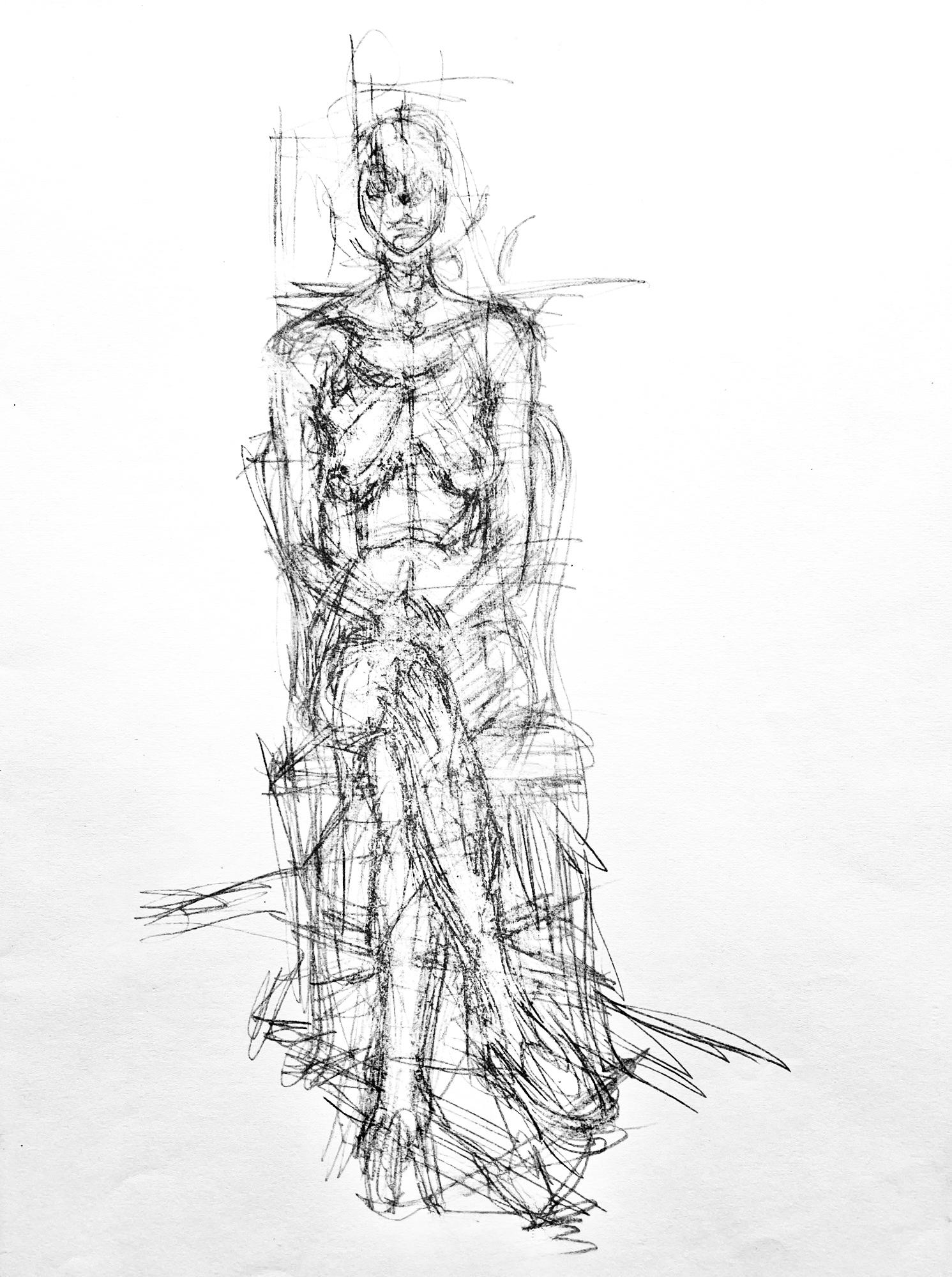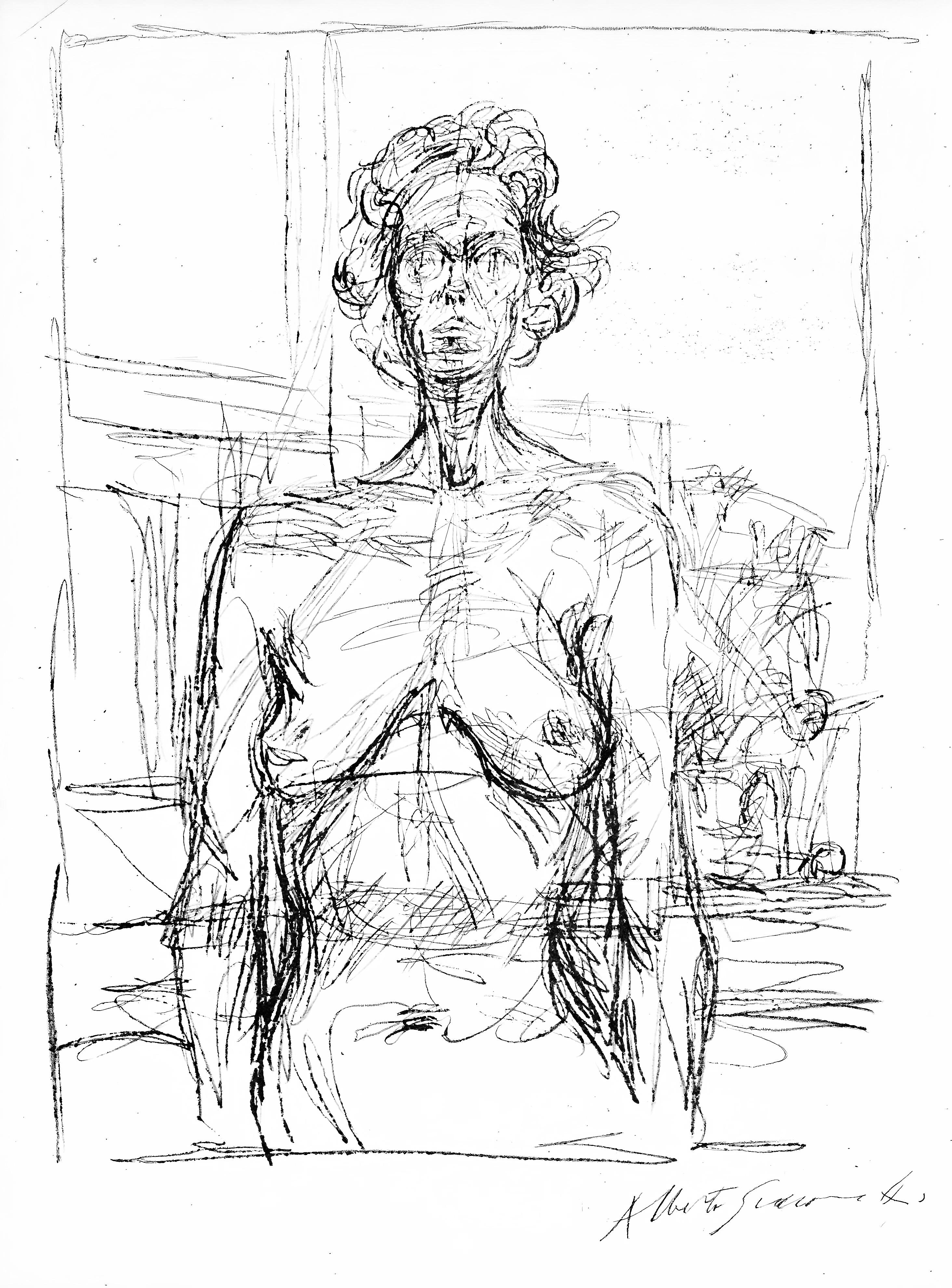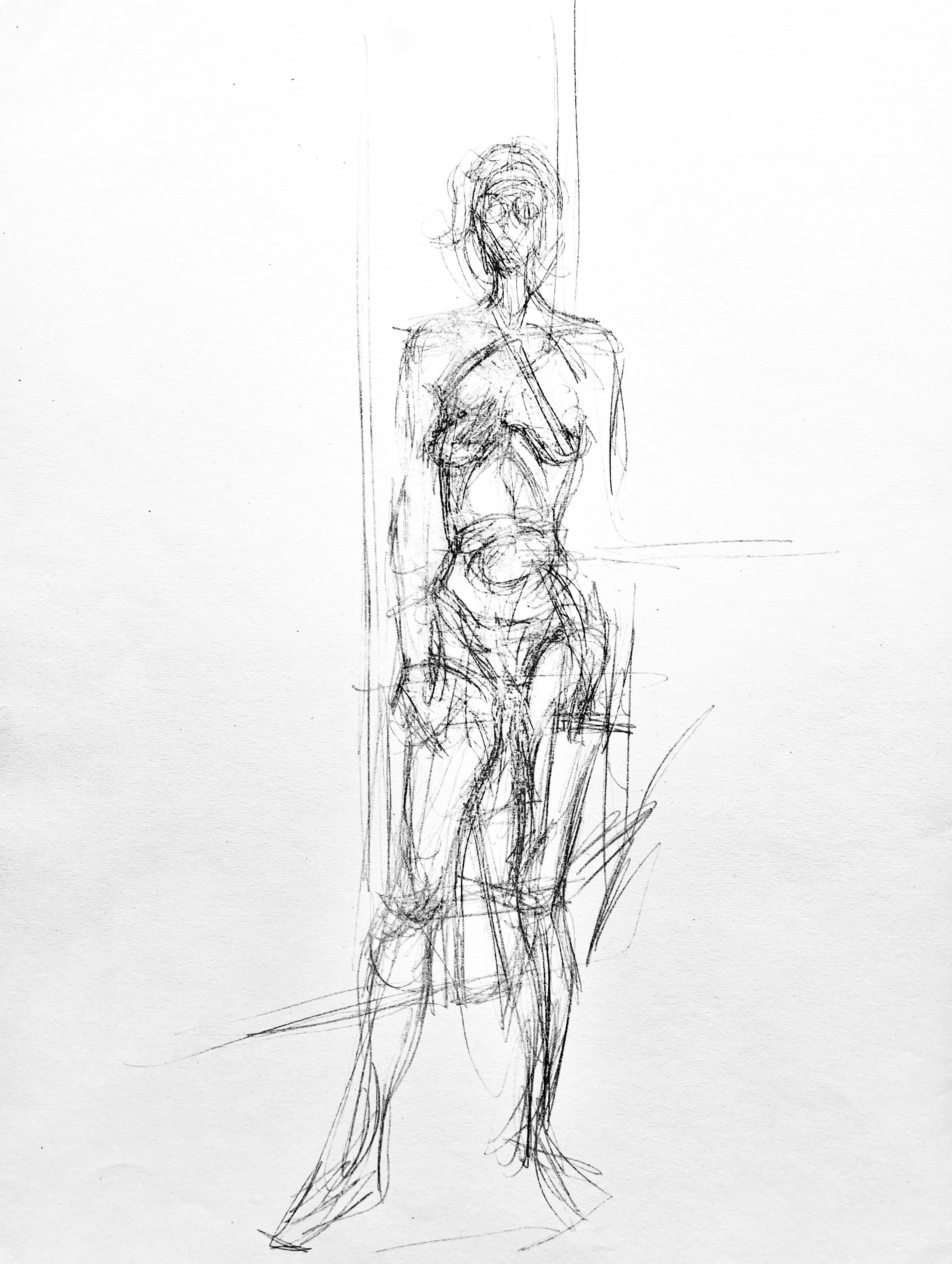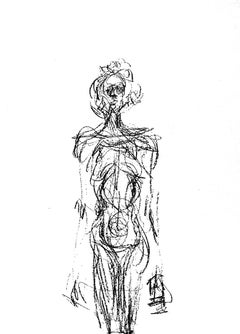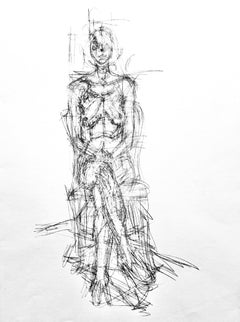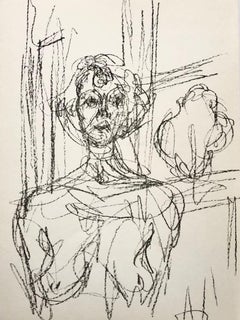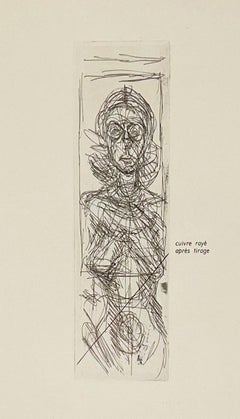Items Similar to Alberto Giacometti, Annette, Frontal View, from Derriere le miroir, 1956 (after)
Want more images or videos?
Request additional images or videos from the seller
1 of 11
Alberto Giacometti, Annette, Frontal View, from Derriere le miroir, 1956 (after)1956
1956
$1,996
$2,49520% Off
£1,551.38
£1,939.2220% Off
€1,756.58
€2,195.7220% Off
CA$2,851.90
CA$3,564.8820% Off
A$3,105.05
A$3,881.3120% Off
CHF 1,625.76
CHF 2,032.2020% Off
MX$37,270.91
MX$46,588.6320% Off
NOK 20,518.10
NOK 25,647.6320% Off
SEK 19,239.21
SEK 24,049.0120% Off
DKK 13,117.50
DKK 16,396.8820% Off
About the Item
This exquisite etching after Alberto Giacometti (1901–1966), titled Annette de Face (Annette, Frontal View), from the folio Derriere le miroir, 10 Ans d'Edition 1946-1956, No. 92-93, originates from the 1956 edition published by Maeght Editeur, Paris, and printed by Atelier Crommelynck, Paris, 1956. This work exemplifies Giacometti’s mastery of line and existential sensitivity, capturing the haunting stillness and psychological intensity of his wife and muse, Annette.
Executed as an etching, cuivre rayé apres tirage on velin paper, this work measures 15 x 11 inches overall; 8.07 x 2.28 inches image size. Unsigned and unnumbered as issued. The edition exemplifies the superb craftsmanship of Atelier Crommelynck, Paris.
Artwork Details:
Artist: After Alberto Giacometti (1901–1966)
Title: Annette de Face (Annette, Frontal View), from the folio Derriere le miroir, 10 Ans d'Edition 1946-1956, No. 92-93
Medium: Etching, cuivre rayé apres tirage on velin paper
Dimensions: 15 x 11 inches, overall; 8.07 x 2.28 inches, image size (38.1 x 27.94 cm; 20.5 x 5.8 cm)
Inscription: Unsigned and unnumbered as issued
Date: 1956
Publisher: Maeght Editeur, Paris
Printer: Atelier Crommelynck, Paris
Condition: Well preserved, consistent with age and medium
Provenance: From the folio Derriere le miroir, 10 Ans d'Edition 1946-1956, No. 92-93, published by Maeght Editeur, Paris; printed by Atelier Crommelynck, Paris, 1956
Notes:
Excerpted from the folio (translated from French), This catalogue, forming a special issue of Derriere le miroir, was completed in October 1956 on the presses of Draeger Freres on behalf of Aime Maeght, Editeur. The original lithographs of Miro, Chagall and Bazaine were shot by Mourlot Freres. The eaux-fortes rayees of Miro and Giacometti were shot by Crommelynck. Raoul Ubac composed and pulled the engraved wood from the cover. The photographs of Braque's reproduced works are by Mr. Routhier. Those of the other artists of Y. Hervochon.
About the Publication:
Derriere le miroir (Behind the Mirror) was one of the most important art publications of the 20th century, created and published by Maeght Editeur in Paris from 1946 to 1982. Founded by the visionary art dealer and publisher Aime Maeght, the series served as both an exhibition catalogue and a work of art in its own right, uniting original lithographs by leading modern and contemporary artists with critical essays, poetry, and design of the highest quality. Printed by master lithographers such as Mourlot Freres and Arte, Derriere le miroir became synonymous with the artistic vanguard of postwar Europe. Each issue was devoted to a single artist or theme and published to accompany exhibitions at the Galerie Maeght in Paris, featuring works by Pablo Picasso, Henri Matisse, Georges Braque, Joan Miro, Marc Chagall, Alexander Calder, Fernand Leger, and Alberto Giacometti, among others. The publication reflected Maeght's belief that art should be both accessible and elevated—an ideal realized through its luxurious production values, meticulous printing, and collaboration with the greatest creative minds of its time.
About the Artist:
Alberto Giacometti (1901–1966) was a Swiss sculptor, painter, and draughtsman whose hauntingly elongated figures and existential vision redefined modern art and made him one of the most influential artists of the 20th century. Born in Borgonovo, Switzerland, into an artistic family—his father, Giovanni Giacometti, was a noted Post-Impressionist—he was immersed in art from an early age before studying in Geneva and moving to Paris in 1922, where he became part of the city’s avant-garde alongside Pablo Picasso, Alexander Calder, Salvador Dali, Joan Miro, Wassily Kandinsky, Marcel Duchamp, and Man Ray. In the 1920s and 1930s, Giacometti explored Cubism and Surrealism, creating symbolic and dreamlike sculptures such as Suspended Ball (1930–31) and The Palace at 4 A.M. (1932), which reflected the influence of Dali, Duchamp, and Man Ray. By the 1940s, he abandoned Surrealism to pursue a deeply personal exploration of the human condition, developing his iconic attenuated figures that embodied both fragility and resilience. His signature sculptures—L’Homme qui marche I (Walking Man I), Femme debout, and Le Chariot—expressed the isolation, endurance, and vulnerability of modern existence, echoing the existential philosophy of Jean-Paul Sartre and Simone de Beauvoir. Giacometti’s figures, stripped of mass yet monumental in spirit, symbolized humanity’s search for meaning in a postwar world, while his paintings and drawings—portraits of his brother Diego, his wife Annette, and his friends—captured the psychological depth of perception with trembling, repetitive lines that blurred the boundary between body and soul. His friendships with Picasso, Calder, Miro, and Kandinsky shaped his understanding of form, motion, and space, while his philosophical engagement with Duchamp and Man Ray deepened his inquiry into the nature of reality and perception. Working obsessively in his modest Montparnasse studio, Giacometti pursued art as an existential act—destroying and rebuilding his figures in an endless search for truth. His influence on postwar art was immense, shaping the work of Henry Moore, Francis Bacon, Louise Bourgeois, Lucian Freud, and later contemporary sculptors such as Antony Gormley and Anselm Kiefer. His aesthetic also resonated beyond sculpture, influencing fashion, photography, and architecture through his vision of form, isolation, and proportion. Giacometti’s work is represented in major museum collections including MoMA, the Tate Modern, and the Centre Pompidou, and continues to inspire artists, collectors, and thinkers worldwide. Standing alongside Pablo Picasso, Alexander Calder, Salvador Dali, Joan Miro, Wassily Kandinsky, Marcel Duchamp, and Man Ray, Giacometti remains a towering figure in modern art—a sculptor-philosopher who transformed the human form into a universal symbol of resilience and reflection. His highest auction record was achieved by L’Homme qui marche I (Walking Man I), which sold for 141.3 million USD at Sotheby’s, London, on February 3, 2010, reaffirming Alberto Giacometti’s enduring legacy as one of the most visionary, profound, and collectible artists in the history of modern art.
After Alberto Giacometti Annette de Face 1956, Giacometti Derriere le miroir No. 92-93, Giacometti etching cuivre raye, Giacometti Maeght Editeur, Giacometti velin paper, Giacometti collectible print.
About the Seller
4.9
Platinum Seller
Premium sellers with a 4.7+ rating and 24-hour response times
Established in 1978
1stDibs seller since 2021
1,219 sales on 1stDibs
Typical response time: <1 hour
- ShippingRetrieving quote...Shipping from: Southampton, NY
- Return Policy
More From This Seller
View AllAlberto Giacometti, Nude in Profile, from Derriere le miroir, 1956 (after)
By Alberto Giacometti
Located in Southampton, NY
This exquisite etching after Alberto Giacometti (1901–1966), titled Nu de Profil (Nude in Profile), from the folio Derriere le miroir, 10 Ans d'Edition 1946-1956, No. 92-93, originates from the 1956 edition published by Maeght Editeur, Paris, and printed by Atelier Crommelynck, Paris, 1956. This work exemplifies Giacometti’s mastery of line and existential sensitivity, capturing the fragility, grace, and introspection that define his vision of the human form.
Executed as an etching, cuivre rayé apres tirage on velin paper, this work measures 15 x 11 inches overall; 12.2 x 2.17 inches image size. Unsigned and unnumbered as issued. The edition exemplifies the superb craftsmanship of Atelier Crommelynck, Paris.
Artwork Details:
Artist: After Alberto Giacometti (1901–1966)
Title: Nu de Profil (Nude in Profile), from the folio Derriere le miroir, 10 Ans d'Edition 1946-1956, No. 92-93
Medium: Etching, cuivre rayé apres tirage on velin paper
Dimensions: 15 x 11 inches, overall; 12.2 x 2.17 inches, image size (38.1 x 27.94 cm; 31 x 5.5 cm)
Inscription: Unsigned and unnumbered as issued
Date: 1956
Publisher: Maeght Editeur, Paris
Printer: Atelier Crommelynck, Paris
Condition: Well preserved, consistent with age and medium
Provenance: From the folio Derriere le miroir, 10 Ans d'Edition 1946-1956, No. 92-93, published by Maeght Editeur, Paris; printed by Atelier Crommelynck, Paris, 1956
Notes:
Excerpted from the folio (translated from French), This catalogue, forming a special issue of Derriere le miroir, was completed in October 1956 on the presses of Draeger Freres on behalf of Aime Maeght, Editeur. The original lithographs of Miro, Chagall and Bazaine were shot by Mourlot Freres. The eaux-fortes rayees of Miro and Giacometti were shot by Crommelynck. Raoul Ubac composed and pulled the engraved wood from the cover. The photographs of Braque's reproduced works are by Mr. Routhier. Those of the other artists of Y. Hervochon.
About the Publication:
Derriere le miroir (Behind the Mirror) was one of the most important art publications of the 20th century, created and published by Maeght Editeur in Paris from 1946 to 1982. Founded by the visionary art dealer and publisher Aime Maeght, the series served as both an exhibition catalogue and a work of art in its own right, uniting original lithographs by leading modern and contemporary artists with critical essays, poetry, and design of the highest quality. Printed by master lithographers such as Mourlot Freres and Arte, Derriere le miroir became synonymous with the artistic vanguard of postwar Europe. Each issue was devoted to a single artist or theme and published to accompany exhibitions at the Galerie Maeght in Paris, featuring works by Pablo Picasso, Henri Matisse, Georges Braque, Joan Miro, Marc Chagall, Alexander Calder, Fernand Leger, and Alberto Giacometti, among others. The publication reflected Maeght's belief that art should be both accessible and elevated—an ideal realized through its luxurious production values, meticulous printing, and collaboration with the greatest creative minds of its time.
About the Artist:
Alberto Giacometti (1901–1966) was a Swiss sculptor, painter, and draughtsman whose hauntingly elongated figures and existential vision redefined modern art and made him one of the most influential artists of the 20th century. Born in Borgonovo, Switzerland, into an artistic family—his father, Giovanni Giacometti, was a noted Post-Impressionist—he was immersed in art from an early age before studying in Geneva and moving to Paris in 1922, where he became part of the city’s avant-garde alongside Pablo Picasso, Alexander Calder, Salvador Dali, Joan Miro, Wassily Kandinsky, Marcel Duchamp, and Man Ray. In the 1920s and 1930s, Giacometti explored Cubism and Surrealism, creating symbolic and dreamlike sculptures such as Suspended Ball (1930–31) and The Palace at 4 A.M. (1932), which reflected the influence of Dali, Duchamp, and Man Ray. By the 1940s, he abandoned Surrealism to pursue a deeply personal exploration of the human condition, developing his iconic attenuated figures that embodied both fragility and resilience. His signature sculptures—L’Homme qui marche I (Walking Man I), Femme debout, and Le Chariot—expressed the isolation, endurance, and vulnerability of modern existence, echoing the existential philosophy of Jean-Paul Sartre and Simone de Beauvoir. Giacometti’s figures, stripped of mass yet monumental in spirit, symbolized humanity’s search for meaning in a postwar world, while his paintings and drawings—portraits of his brother Diego, his wife Annette, and his friends—captured the psychological depth of perception with trembling, repetitive lines that blurred the boundary between body and soul. His friendships with Picasso, Calder, Miro, and Kandinsky shaped his understanding of form, motion, and space, while his philosophical engagement with Duchamp and Man Ray deepened his inquiry into the nature of reality and perception. Working obsessively in his modest Montparnasse studio, Giacometti pursued art as an existential act—destroying and rebuilding his figures in an endless search for truth. His influence on postwar art was immense, shaping the work of Henry Moore, Francis Bacon, Louise Bourgeois, Lucian Freud, and later contemporary sculptors such as Antony Gormley and Anselm Kiefer. His aesthetic also resonated beyond sculpture, influencing fashion, photography, and architecture through his vision of form, isolation, and proportion. Giacometti’s work is represented in major museum collections including MoMA, the Tate Modern, and the Centre Pompidou, and continues to inspire artists, collectors, and thinkers worldwide. Standing alongside Pablo Picasso, Alexander Calder, Salvador Dali, Joan Miro, Wassily Kandinsky, Marcel Duchamp, and Man Ray, Giacometti remains a towering figure in modern art—a sculptor-philosopher who transformed the human form into a universal symbol of resilience and reflection. His highest auction record was achieved by L’Homme qui marche I (Walking Man I), which sold for 141.3 million USD at Sotheby’s, London, on February 3, 2010, reaffirming Alberto Giacometti’s enduring legacy as one of the most visionary, profound, and collectible artists in the history of modern art.
After Alberto Giacometti Nu de Profil 1956, Giacometti Derriere le miroir No. 92-93, Giacometti etching...
Category
1950s Modern Abstract Prints
Materials
Etching
$1,996 Sale Price
20% Off
Free Shipping
Alberto Giacometti, Standing Woman, from Derriere le miroir, 1961 (after)
By Alberto Giacometti
Located in Southampton, NY
This exquisite lithograph after Alberto Giacometti (1901–1966), titled Femme debout (Standing Woman), from the folio Derriere le miroir, No. 127, originates from the 1961 edition pub...
Category
1960s Modern Abstract Prints
Materials
Lithograph
$716 Sale Price
20% Off
Free Shipping
Alberto Giacometti, Seated Woman, from Derriere le miroir, 1954 (after)
By Alberto Giacometti
Located in Southampton, NY
This exquisite lithograph after Alberto Giacometti (1901–1966), titled Femme assise (Seated Woman), from the folio Derriere le miroir, No. 65, originates from the 1954 edition publis...
Category
1950s Modern Abstract Prints
Materials
Lithograph
$716 Sale Price
20% Off
Free Shipping
Alberto Giacometti, Standing Woman and Head of Man, 1961 (after)
By Alberto Giacometti
Located in Southampton, NY
This exquisite lithograph after Alberto Giacometti (1901–1966), titled Femme debout et Tete d'homme (Standing Woman and Head of Man), from the folio Derriere le miroir, No. 127, orig...
Category
1960s Modern Abstract Prints
Materials
Lithograph
$716 Sale Price
20% Off
Free Shipping
Giacometti, Composition (Kornfeld 322; Lust 32), Derrière le miroir (after)
By Alberto Giacometti
Located in Southampton, NY
Lithograph on vélin Chiffon de Mandeure paper. Signed in the plate and unnumbered, as issued. Good condition. Notes: From the album, Lithographies et Eaux-Fortes Originales, Livres I...
Category
1960s Modern Abstract Prints
Materials
Lithograph
$1,436 Sale Price
20% Off
Free Shipping
Alberto Giacometti, Standing Nude, from Derriere le miroir, 1954 (after)
By Alberto Giacometti
Located in Southampton, NY
This exquisite lithograph after Alberto Giacometti (1901–1966), titled Nu debout (Standing Nude), from the folio Derriere le miroir, No. 65, originates from the 1954 edition publishe...
Category
1950s Modern Abstract Prints
Materials
Lithograph
$716 Sale Price
20% Off
Free Shipping
You May Also Like
Alberto Giacometti - Portrait
By Alberto Giacometti
Located in Collonge Bellerive, Geneve, CH
Alberto Giacometti - Portrait
Engraving (after the drawing)
Published in the deluxe art review, XXe Siecle
1956
Dimensions: 32 x 24 cm
Publisher: G. di San Lazzaro.
From the art Re...
Category
1950s Modern Abstract Prints
Materials
Engraving
Untitled By Alberto Giacometti
By Alberto Giacometti
Located in Dubai, Dubai
Untitled
By Alberto Giacometti
Alberto Giacometti was a Swiss sculptor and painter known for his distinctive, elongated figures that convey a sense of existential loneliness and h...
Category
1960s Contemporary Figurative Prints
Materials
Lithograph
Annette Facing Front
By Alberto Giacometti
Located in Washington, DC
Artist: Alberto Giacometti
Title: Annette Facing Front
Portfolio: Derriere le Miroir Tenth Anniversary Edition
Medium: Etching
Date: 1956
Edition: 2000
Frame Size: 19 1/2" x 14 1/4"
...
Category
1950s Modern Figurative Prints
Materials
Etching
Figure Miroir
Located in San Francisco, CA
This artwork titled "Figure Miroir" c.1980 is an original lithograph on Arches paper by noted French abstract expressionist artist Francois Rouan, b.194...
Category
Late 20th Century Abstract Expressionist Abstract Prints
Materials
Lithograph
Alberto Giacometti, 'Nu' original lithograph, 1961
By Alberto Giacometti
Located in Pembroke Pines, FL
Artist: Alberto Giacometti
Title: 'Nu'
Year: 1961
Medium: Original Lithograph on vélin paper
Dimensions: 15in. by 11in.
Edition: From the rare limited edition
Reference : Lust, 148-1...
Category
1960s Contemporary Prints and Multiples
Materials
Lithograph
Alberto Giacometti, 'Nu' original lithograph, 1961
By Alberto Giacometti
Located in Pembroke Pines, FL
Artist: Alberto Giacometti
Title: 'Nu'
Year: 1961
Medium: Original Lithograph on vélin paper
Dimensions: 15in. by 11in.
Edition: From the rare limited edition
Reference : Lust, 148-1...
Category
1960s Contemporary Prints and Multiples
Materials
Lithograph

